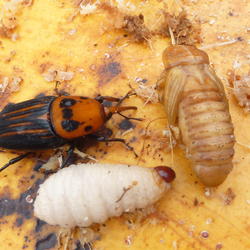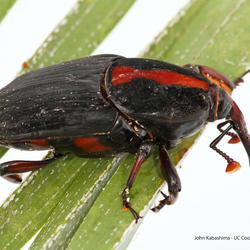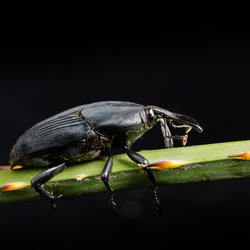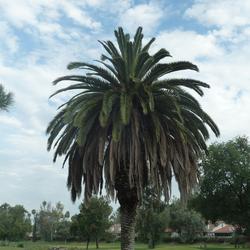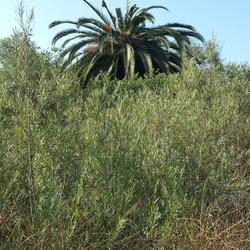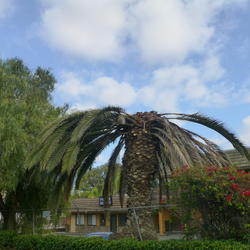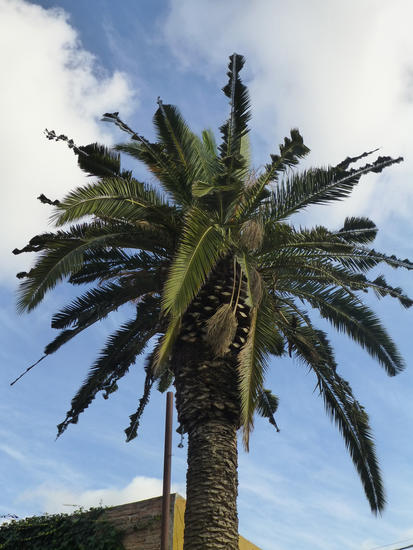Has the South American Palm Weevil, Rhynchophorus palmarum, Established in Southern California?
The Situation: The South American palm weevil, Rhynchophorus palmarum (Coleoptera: Curculionidae), has a known distribution that includes Mexico, Central and South America, and the Caribbean. Like other species of Rhynchophorus, such as the red palm weevil, R. ferrugineus, and the palm weevil R. vulneratus, R. palmarum is a destructive palm pest in its native and invaded ranges.
Survey responses help southern California scientists collect data on this new pest and document it's affects on local palms.
Feeding by weevil larvae in the crown of palm trees, causes significant damage that may result in the death of meristematic tissues. If meristematic tissue is destroyed, it results in the “crown” of the palm dying and this inability to produce new fronds gradually leads to palm death. Palms, especially highly susceptible Canary Islands date palms, Phoenix canariensis, that are in the advanced stages of decline often have a “halo” of green fronds around the apex of the trunk and the palm crown has disintegrated.
|
|
|
|
|
strong vertical central fronds |
Sweetwater Regional Park, Bonita San Diego County. 26 June 2016. |
San Ysidro, San Diego County, California USA. Note the “halo” of fronds around the trunk apex |
Detection of R. palmarum in California was officially confirmed on 9 May 2011 by USDA and seven additional detections were made over July – August 2011. These initial detections were in San Ysidro in San Diego County, about 2.5 miles from the USA – Mexico border. It is likely that San Diego County was invaded by weevils that originated from Tijuana Mexico, where infestations and dead palms had been detected earlier (December 2010).
/document/palm-weevil-bucket-trappdf
/document/palm-weevil-bucket-trappdf
Pheromone Trap Surveys for Rhynchophorus palmarum in California. In response to the threat R. palmarum posed to ornamental, date, and native palms in California, a delineation program using bucket traps loaded with bait (fermenting fruit) and commercially-available aggregation pheromone was initiated in California. With funding from the USDA-APHIS, the California Department of Food and Agriculture (CDFA) deployed 998 bucket traps across 12 Counties with commercial palm nurseries. Traps were monitored over 2011-2013 until Federal funding for the monitoring program expired.
The distribution of traps was as follows: (1) Alameda County – 20 traps; (2) Imperial County – 150 traps; (3) Los Angeles County – 73 traps; (4) Orange County – 200 traps; (5) Riverside County – 210 traps; (6) San Bernardino County – 25 traps; (7) San Diego County – 200 traps; (8) Santa Barbara County – 20 traps; (9) Santa Clara County – 30 traps; (10) Santa Cruz County – 10 traps; (11) Sonoma County – 10 traps; (12) Ventura County – 50 traps.
A total of 111 R. palmarum were captured in California; 109 in San Diego County (sex ratio was 57% female) over 9 May 2011 to 10 October 2013, and in Imperial County 2 weevils were trapped, 1 male on 4 August 2011 and 1 female on 5 September 2011.
Trapping programs for R. palmarum in Alamo Texas and Yuma Arizona resulted in detections in both states on 3 May 2012 and 20 May 2015, respectively.
Visual Surveys for Rhynchophorus palmarum in Tijuana. Surveys for R. palmarum activity in Tijuana Mexico in May 2016 revealed large numbers of dead Canary Islands date palms. In a casual 8 hr driving survey across Tijuana approximately 125 dead Canary Islands date palms exhibiting damage typical of R. palmarum were found in residential areas.
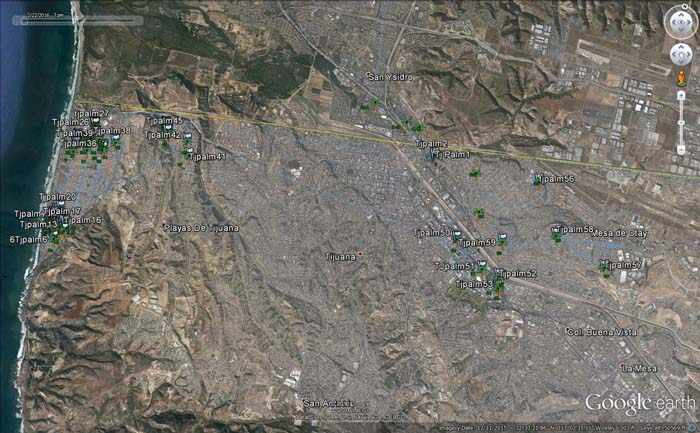
found in Tijuana on 24 May 2016. Dead palms attributable to R. palmarum have
also been observed in Rosarito, Baja California, Mexico (recorded 23 June 2014).
In Tijuana, many single dead palms were found along roadsides and occasionally multiple dead palms would be observed in parks or around schools. In addition to dead palms, some living palms displayed spectacular levels of feeding damage to fronds.
Red Ring Nematode, Bursaphelenchus cocophilus. Adult R. palmarum spread (i.e., vector) juvenile stages of red ring nematode . Nematodes are deposited on palms in very close proximity to oviposition wounds females make when laying eggs. This damage provides entry for nematodes into palms and immature nematodes mature and reproduce inside palms. Immature nematodes can apparently infest weevil larvae and remain in an immature stage until larvae pupate. Newly emerged adult weevils then carry red ring nematodes within their bodies to new palm hosts. Nematodes don’t develop inside weevils. Adult weevils may acquire nematodes when feeding on infected palm material or nematodes may attach to the body surface of weevils. When adult weevils fly to another palm they may carry these hitch hiking nematodes on the outside of their bodies. Nematodes may reside inside tracheal sacs, part of the weevil’s tube-like breathing system, from where they can move to the ovipositor (i.e., egg laying tube) of female weevils. When females use the ovipositor to lay eggs into wounds they have chewed into palms, nematodes are also deposited into the opening. Nematodes can also be found in R. palmarum frass (i.e., excrement).
Nematodes feed internally and infestations often result in palm death. The common name, red ring nematode, comes from reddish lesions that form in infested stems and trunks. When infested stems and trunks are cut in cross section the red lesions look like red rings.
Dissections of the 111 the adult R. palmarum captured in San Diego and Imperial counties failed to detect the presence of red ring nematode. As of 24 June 2016, this nematode is not known from California.
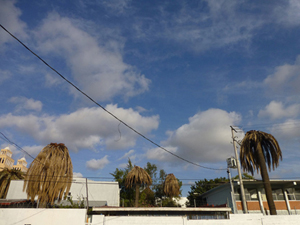
the grounds of Escuela Secundaria 2 Leyes de Reforma,
Libertad, Tijuana, Baja Calif
What is the Threat to California? The South American palm weevil and red ring nematode (should it establish in California) have the potential to cause significant damage to native and non-native palms in California. Palms are ubiquitous in the California landscape and they give urban and beach areas a distinct appearance that is strongly thought of as being southern Californian. The ornamental palm industry has an estimated value of $70 million while commercial date producers in the Coachella and Imperial Valleys contribute about $30 million to California’s economy.
fronds in Tijuana, Mexico. 24 May 2016
California has a native palm species, Washingtonia filifera, which grows in desert oases and may be vulnerable to attack by R. palmarum and red ring nematode.
Palm mortality caused by feeding weevils will be a costly management expense for home and business owners as removing large dead palms is difficult.
Large numbers of wilding Canary Islands date palms grow in unmanaged riparian areas and will provide abundant food for weevils. Additionally, laboratory studies suggest that Rhynchophorusspecies of palm weevils have better survivorship when their environments are damp and humid. Riparian areas in California with susceptible palm species may provide good habitat for weevil populations to proliferate. From here they can spread into urban and agricultural areas. For example, the Sweetwater Regional Park in Bonita San Diego County, has hundreds of naturalized Canary Islands date palms growing in wash areas near the Western Staging Area (intersection of Bonita Road and Lynwood Drive). Google Earth imagery (satellite photos taken 22 March 2016) near the eastern Willow Street –Bonita Road entrance to the park clearly show dead Canary Islands date palms that may have been killed by R. palmarum. These areas are surrounded by densely populated urban areas that have an impressive number and species variety of palms.
More Media on the South American Palm Weevil
Los Angeles Times: L.A.'s palm trees are dying and it's changing the city's famous skyline
KMIR News : Invasive Bug Killing Palms Found in Valley
ABC7 News: SoCal's Palm Trees Threatened by South American Weevil
KPBS: Invasive Insect Threaens San Diego County's Palm Trees
NBC San Diego: Palm-Killing Weevil Poses Threat to Southern California Region
AgAlert: Scientists work to define threat from palm pest
New York Times: California Today: An Invasive Beetle Threatens State’s Southern Palm Trees
Farm2Ranch: Scientist work to define threat from palm pest
Times of San Diego: Are Weevils Destroying Palm Trees in San Diego?
County News Center: Public's Palm-reading Needed to Ward Off Weevil
Executive Order: President Obama issues EO to Protect the US from Invasive Species
Farm Advisor: Palmageddon: The Invasion of California by the South American Palm Weevil
CBS 8 News Invasive Weevil: Tiny insect poses huge threat to San Diego palm trees
Los Angeleno Los Angeleno: The ‘Indiana Jones of Insects’ Rescuing SoCal Palm Trees
PalmArbor: South American Palm Weevil
KMIR News : Invasive Bug Killing Palms Found in Valley
ABC7 News: SoCal's Palm Trees Threatened by South American Weevil
CBS Los Angeles: Tiny Bug Looking to Take Out the Statuesque Palm Tree
County of San Diego: Evil Weevil Threatening Date Palm Trees
Invasive.org: South American Palm Weevil
UCR Blog: Laguna Beach Palm Removal
Center for Invasive Species Research, University of California, Riverside
Text and leaf damage photo provided by: Mark S. Hoddle, thrips photos by Mike Lewis
Mark Hoddle, Extension Specialist and Director of Center for Invasive Species Research
mark.hoddle@ucr.edu
Personal Website
